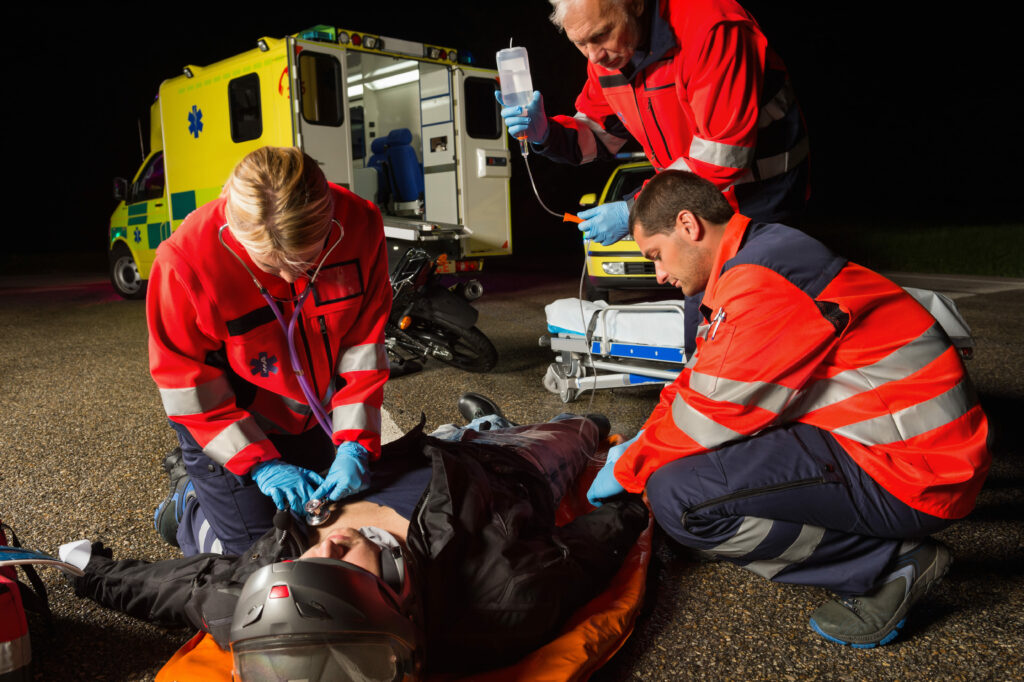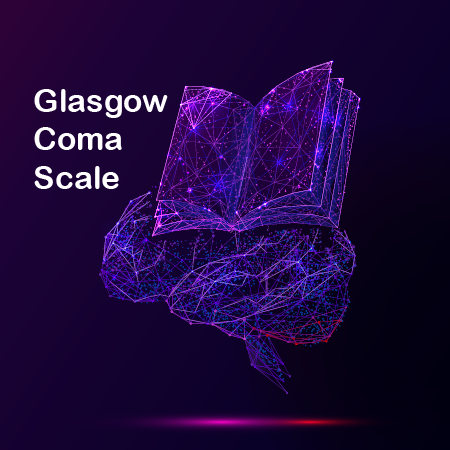Glasgow Coma Scale
The Glasgow Coma Scale was originally developed in 1974 as a relatively easy exam that can quickly establish neurological status to guide trauma care.
What is great about the score is it does not require a high level of training or education to be able to perform, and with some time and repeated exposure, anyone can learn how to do the assessment.
It is ultimately used to establish the patients level of consciousness or mental status after head trauma, but can be used outside of trauma applications as well.
The Glasgow Coma Scale (GCS) is made up of three components graded from a total of 3-15, with a maximum of 15 being what is normal.
The three components of the GCS are: Eyes, Verbal, Motor. Each of those categories is worth at least 1 point each, which gets us our minimum score of 3.
Using the GCS to assess for traumatic brain injury
- GCS can also be used to help identify the severity of traumatic brain injuries (TBI), and is recoginized by many instituions, including National Registry to be a marker for TBI.
- GCS of 13-15 = Mild TBI
- GCS of 9-12 = Moderate TBI
- GCS of 3-8 = Severe TBI
- Repeated GCS assessments will be important, as it can let you know how the patients status may be evolving, and in exactly what way.
- It is important to keep in mind that early in the history of the GCS it was used primarily for neurologial assessments for trauma patients, and maybe that can help you remember that you can use it for a TBI
The parts of a GCS assessment
While there are some small differences between the adult and pediatric/infant GCS assessment, this is going to focus on the adult GCS assessment and terminology. Keep in mind, that as you are doing these assessments – you are basing it off of their absolute best assessment. And this will be important later.
- Three Components
- Eyes – 4 points total
- 4 – Opens eyes spontaneously
- 3 – Opens eyes to verbal stimulus
- 2 – Opens eyes to a painful stimulus
- 1 – Does not open eyes to any stimulus
- Verbal – 5 points total
- 5 – Oriented speech
- 4 – Confused speech
- 3 – Inappropriate words
- 2 – Incomprehensible sounds
- 1 – No speech
- Motor – 6 points total
- 6 – Follows commands
- 5- Localizes pain
- 4 – Withdraws from pain
- 3 – Decorticate Posturing (internal flexing)
- 2 – Decerebrate Posturing (external flexing)
- 1 – No motor response
- Eyes – 4 points total
Now that we know the parts of the assessment and what the score means, we can start getting into the scenarios and put it to practice.
Your first call
Our first call of the shift was you responding to the scene of an assault with local police who are with a patient. You have a 23 year old male who is up walking around, having a conversation back and forth with a police officer as you arrive on scene after he had been assaulted.
- When you look at this patient, based off this description we can have a few clues as to how the patient is.
We know that he is having a conversation with a police officer, so we see that his eyes are tracking the police officer, and that he is conversing back and forth.
Based off of this, we know that he will have- 4 points for eyes, and as
- he is speaking coherently we know that it is oriented speech, so 5 points.
- With this patient walking around, we can see he has motor control, and this is going to give him 6 points for his motor as he does show coordination.
Based off of these pieces of information we can see that he has a GCS of 15.
E-4,V-5,M-6

Your second call
Our next call is going to be for a 35 year old female who is not acting right. You arrive on scene and see a woman who is walking around steadily, is looking at you as you walk up, but as you go to speak to her, the words she is saying does not actually match what it seems she is trying to say, and she gets frustrated as you’re doing your assessment, but does not appear to be frustrated at you.
- In this situation we have a woman who could be similar to the woman in the video here. She is clearly with it: https://www.youtube.com/watch?v=A5wAak66HDI
- Her eyes are open (4 points) and
- She has motor control as she is holding the microphone and moving around (6 points for motor).
- As we speak to her, we notice that she is making coherent words – but she is not actually making any sense (3 points for verbal).
- And as she tries to speak she gets increasingly frustrated. In this video here, you will notice a woman who is similar to this situation.
- This woman is known as Serene Branson. She is a woman who had a migraine on live TV while she was acting as a reporter.
Now, based off of this we can infer that her GCS score is going to be 13. E-4,V-3,M-6

The last call
- On the last call of your shift you arrive on scene for a 19 year old male who was ejected out of his vehicle during a car crash. As you arrive on scene, you notice that other providers are on scene speaking with the patient while they are preparing to put him on the backboard. You stop the crew as you walk up, and do a very quick assessment prior to him being moved.
- What you notice is he is awake, he has an oxygen mask on and he is looking directly at you as you speak to him (4 points for eyes).
- He is clearly able to respond to each question you ask, but does appear confused and he is not understanding exactly what you say. He does speak full sentences however (4 points for verbal).
- You start to do a pulse, motor, and sensory test (PMS) and notice that he does not move his extremities at all. He is not able to move any of his extremities, and he also cannot feel anything from the neck down.
This case is strange and can have the case made for it two ways and it involves his motor assessment. If you ask him to blink, does that count as following commands?
Does him being unable to move or feel any of his extremities make it where he does not have any motor function?
If you count him blinking, then he would have 6 points for motor.
If you don’t believe that fits then he would have 1 point for motor as he cannot move at all, and cannot adequately follow commands.
Based off of this, he will either have a score of 15 – or a score of 9.
That is a pretty drastic change in score, and we can agree that he is not neurologically intact based off of the fact he cannot move or feel anything.
This patient has confused speech, and he cannot follow commands even though he does have the ability to blink. Does this mean he is neurologiclaly intact? He is unable to localize pain, he cannot withdraw from pain, and he is not able to posture. This patient likely has a severe spinal trauma in some capacity, and his neurological function is impaired.

Final notes
When it comes to the Glasgow Coma Scale, it is important to remember that it is just a tool, and it can help guide some decisions that you may make.
If you get confused, you can always remember that 1 is none for each category, and that you have 3 categories (so your minimum score is 3).
- When it comes to knowing how many points fit in each category, you can remember
- 4 eyes – What did the person with glasses get called in elementary school? 4 eyes.
- 5 verbal – The Jackson 5 were a musical group, and singing has everything to do with verbal. And there were 5 members of The Jackson 5.
- 6 motor – If someone is pretty proud of their vehicle or car, you may hear them say “Oh it’s a V6” referencing the engine. V6 would be 6 motor.
- There is a difference between an engine and a motor, but you can look that up on your own. If these memory tools may help, then
that’s all that matters. Whatever silly thing helps you remember.
- There is a difference between an engine and a motor, but you can look that up on your own. If these memory tools may help, then
There are many ways to remember the GCS and their points. And remembering all the parts that are between none and normal can be confusing. But just know that it doesn’t have to take a lot of training, just a little focused practice with repetition and you will start being able to do this much quicker and easier.
Start to do this as you find yourself on the ambulance, and you will get better and better. If you’re interested in additional resources, we have a brief study guide for all the main systems available for free, with even more available if you subscribe and create a paid account today.
